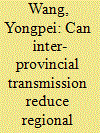| Srl | Item |
| 1 |
ID:
192750


|
|
|
|
|
| Summary/Abstract |
Plagued by worsening pollution in load centers along the eastern coastal regions such as Beijing-Tianjin -Hebei, China is reducing local coal-fired power plants in those regions and relying more on inter-regional power transmission. In recent years, China has accelerated the construction of the West-East Electricity Transmission Project and planned and constructed a number of Ultra-high Voltage (UHV) transmission lines. However, how the impact of inter-regional transmission on carbon emissions needs empirical verification. This paper aims to study the carbon emission reduction effect of inter-regional transmission under nested models of the spatial econometric model for panel data. The empirical results show that although the non-dynamic spatial econometric analysis can find the carbon emission reduction effect of inter-provincial transmission, the long-term effect obtained by the dynamic spatial econometric analysis indicates that the inter-provincial transmission can bring about a slight increase in carbon emissions. The inter-provincial power transmission needs to be supported by sustainable share growth of renewable energy to achieve the targeted mitigation of carbon emissions.
|
|
|
|
|
|
|
|
|
|
|
|
|
|
|
|
| 2 |
ID:
166996


|
|
|
|
|
| Summary/Abstract |
Thermal power plants are considered to be the culprit of various pollutants. In China, a country dominated by coal-fired power generation, the problem is more serious. Regulators must use capacity control of coal-fired power generation as a key policy tool for emission reduction. This paper was concerned about the environmental effect of changes in thermal power capacity utilization on pollutants emissions in China. Under the econometric strategy of panel smoothing transformation regression (PSTR) model, the switching regimes and paths of seven pollutants emissions to thermal power capacity utilization were evaluated with the transition variables of power generation and electricity consumption, respectively. The three statistics, LM test, LMF and pseudo-LRT, unanimously verify the necessity of nonlinearity. In addition to CO2 emissions whose transition function presents U-shaped feature both in the models with power generation and electricity consumption as transition variable, the other pollutants such as SO2, NOX and so on generally exhibit quasi S-shaped change trend. The interaction term of installed capacity and average annual operating hours of thermal power plants introduced to reflect the interactive environmental effect of thermal power capacity utilization on pollutants emissions, appear similarity in most pollutants. However, the negative coefficients of the transition functions for interactive environmental effect imply that the policymakers reduce pollution by defusing capacity, which needs to be supplemented by setting reasonable warning line for operating hours of thermal power.
|
|
|
|
|
|
|
|
|
|
|
|
|
|
|
|